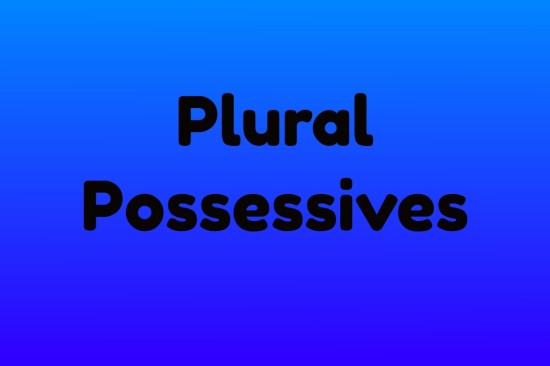Plural Possessives: Why You Put an Apostrophe After the S

It’s common for people to wonder, “What does it mean to put an apostrophe after an S?” It can get a bit confusing. To get it right, you need to understand what a possessive is.
Possessives are used to show ownership; to show that something belongs to someone. “The president’s official airplane” is one example. The airplane belongs to the president, of course. But there is only one president; after all, you don’t have two presidents of the same country. So, this is a singular possessive made by adding an apostrophe and an “s.”
But with a phrase such as “the thieves’ jewels,” you have a plural noun: thieves. Most of the time, a plural noun will be formed by adding “s” to it. In this case, you also change the spelling but don’t worry about that now. The main issue is the final letter, which is “s.” Houses, cats, clouds, essays, rainbows: these are all plural nouns.
As you can see, the fact that the thieves (illegally) possess the jewels is shown simply by adding an apostrophe after the noun and after the letter “s.” They may not possess these valuables for long unless they’re clever and know how to escape the police, but they do for now. And that’s how you form a plural possessive.
To recap, usually if the noun is singular, the apostrophe will go before the s, but if the noun happens to be plural, the apostrophe will go after the s.
Plural Possessive Examples
- The Simpsons’ spaceship (the spaceship belongs to the Simpson family; you make the family name plural to show that you’re referring to all of the family members)
- The dogs’ tails (the tails belong to the dogs)
- The lakes’ water (the water belongs to the lakes)
You have to be careful with the last example because if you only wish to talk about one lake, you must write: “the lake’s water.” In this case, that’s a singular possessive.
An even bigger problem these days is when people write sentences such as this: “None of the monkey’s looked happy in the zoo.” There is no reason to use an apostrophe to make a possessive here. The sentence is only talking about monkeys in the plural. They do not own anything! However, this is a commonly repeated mistake across the Internet.
Sometimes it’s hard to see how the possessive works. “You owe me three months’ pay immediately!” Oh, I do? Let me check my wallet. And my grammar guide. Why is there an apostrophe after “months?” Because the pay is equal to three months of work. In a sense, the pay belongs to those three months. It’s like saying “three months of pay.” If you can use the word “of” in the sentence, then you probably need an apostrophe.
Irregular Plural Possessives
Now that you think you’ve learned all the rules, you’re in for a surprise. There’s another type of plural possessive: the irregular plural possessive. The children’s work was so poorly done that the teacher fainted and had to go to the hospital. Okay, this might not really happen, but I used to be a teacher, and sometimes I felt like fainting!
The main point is this. “Children” is already plural. You cannot add “s” to the word itself to make it plural. So when you want to show possession, you put the apostrophe first, then the “s.” Here are some more examples.
- The women’s babies (“women” is the plural form of “woman”)
- The firemen’s trucks (“firemen” is the plural of “fireman”)
- The dice’s roll (“dice” always means there is more than one)
These look like singular possessives, but they aren’t.
Compound Plural Possessives
You may have thought we had exhausted all of the plural possessives, but there’s one more rule you need to know. It deals with compound plural possessives. For example, “Sam and Dave” is a compound. There are two parts. So which of the following is correct?
- Sam and Dave’s song was number one for six months.
- Sam’s and Dave’s song was number one for six months.
The correct one is the first. Why? Because Sam and Dave made or performed the song together. It belongs to both of them. Only one possessive needs to be given. But you need to be careful.
- Lucy’s and Gina’s cars are the fastest on my street.
- Mick’s and Rod’s views on equal rights are impressive.
In these two examples, you need two possessives, one for each proper noun. Lucy and Gina both have different cars. Mick and Rod have separate views. However, what if Lucy and Gina were mother and daughter, and both of them had the same cars? Then you need to change the sentence to “Lucy and Gina’s cars are the fastest on my street.”
With compound plural possessives, it’s important to remember you have to think a little and decide whether you are talking about two separate people or things, or a single unit with two parts.
